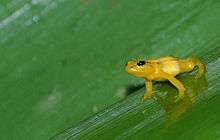Anomaloglossus beebei
Anomaloglossus beebei (common names: Beebe's rocket frog, golden rocket frog) is a species of frog in the family Aromobatidae. It is endemic to Guyana and only found on the Kaieteur Plateau, in the eastern edge of them Pacaraima Mountains.[2] Recently, it has also been found on Mount Ayanganna.[3][4]
| Anomaloglossus beebei | |
|---|---|
 | |
| Scientific classification | |
| Kingdom: | Animalia |
| Phylum: | Chordata |
| Class: | Amphibia |
| Order: | Anura |
| Family: | Aromobatidae |
| Genus: | Anomaloglossus |
| Species: | A. beebei |
| Binomial name | |
| Anomaloglossus beebei (Noble, 1923) | |
| Synonyms | |
|
Colostethus beebei (Noble, 1923) | |
This frog inhabits the tank of the giant bromeliad Brocchinia micrantha.[1] Tadpoles live in small amounts of water trapped in the leaf axils.[5] It is an opportunistic sit and wait predator whose diet includes small arthropods, mosquitos, and midges.
Anomaloglossus beebei has been assessed as being an endangered species because its range is small (<20 km²) and its habitat is slowly being lost by expanding forests.[1]
A couple of researchers have found remarkable differences in the color of the Anomaloglossus beebei, depending on whether it has been grown in captivity or in wildlife conditions. For the latter, it has been seen how a chestnut brown color with a short black dorsal line tends to be a patter between the frogs’ shoulders, as well as reddish-brown forearms, and orange-red limbs. However, if the frogs were to be raised in captivity, their legs would be light brown, and no dorsal markings would be present. This change occurs mainly because of the presence of molecules that are related to phylogeny when they are kept in captivity. This is done for the most part to resolve the alpha-taxonomy of this frog, which has now become a vulnerable species.
It has also been noticed sexual dimorphisms and variations within the species. For example, male Golden Rocket frogs are usually smaller and with their third finger distinctly swollen when compared to females, which are normally larger. The coloration can also be distinct. Males have a densely pigmented black throat, and an orange pigmented belly; whereas females present a yellowish pigmentation in their throats and bellies.
References
- IUCN SSC Amphibian Specialist Group 2019. Anomaloglossus beebei. The IUCN Red List of Threatened Species 2019: e.T55052A120128244. https://doi.org/10.2305/IUCN.UK.2019-1.RLTS.T55052A120128244.en. Downloaded on 20 July 2019.
- Frost, Darrel R. (2014). "Anomaloglossus beebei (Noble, 1923)". Amphibian Species of the World: an Online Reference. Version 6.0. American Museum of Natural History. Retrieved 31 March 2014.
- MacCulloch, R. & Lathrop, A. (2009). "Herpetofauna of Mount Ayanganna, Guyana: Results of the Royal Ontario Museum Ayanganna Expedition 2000". Royal Ontario Museum Science Contributions. Royal Ontario Museum. 4: 1–36.
- Kok, Philippe J.R.; Nicolaï, Michaël P.J.; Lathrop, Amy & MacCulloch, Ross D. (2018). "Anomaloglossus meansi sp. n., a new Pantepui species of the Anomaloglossus beebei group (Anura, Aromobatidae)". ZooKeys. 759: 99–116. doi:10.3897/zookeys.759.24742.
- Kok, P.J.R.; MacCulloch, R.D.; Gaucher, P.; Bourne, G.R.; Poelman, E.H.; Lathrop, A. & Lenglet, G. (2006). "A new species of Colostethus (Anura, Dendrobatidae) from French Guiana with a redescription of Colostethus beebei (Noble, 1923) from its type locality". Phyllomedusa. 5: 43–66.
